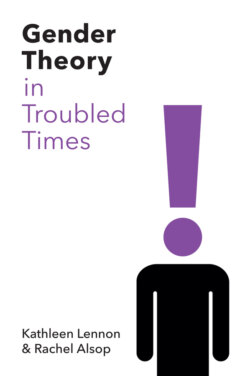Читать книгу Gender Theory in Troubled Times - Rachel Alsop - Страница 8
Doing gender theory
ОглавлениеTo do gender theory we need to explore what is meant by the terms ‘man’ and ‘woman’ and other terms related to them, such as ‘male’ and ‘female’, or ‘masculine’ and ‘feminine’. We also need to consider those which reference our foundational terms, such as ‘gender fluid’ or ‘non-binary’ (discussed in chapter 7). What informs the assignment of people to these categories? And what are the consequences of such assignments? Each of these tasks is inter-implicated with the other, as Beauvoir made clear in her seminal text The Second Sex ([1949] 2010). What we mean by the terms is linked to what informs their assignment to people and the personal and social consequences of such an assignment. ‘But first, what is a woman?’ Beauvoir asks (ibid.: 5). And she recognized – and we follow her – that this question is not answered by looking in a dictionary. To answer this question, we need to look at a range of factors: the biological diversity of bodies; what is made of those bodies in familial and wider social contexts; the economic and wider social structural consequences of sexed positionality and its implications for divisions of labour and power differentials; the (variable) cultural meanings, myths and imaginaries attached to sexed difference; the practices into which we are initiated in order to reproduce differences; the intersection of gendered categories with other aspects of social positionality; and the internalization of these external factors to produce the lived experience of gender – a gendered subjectivity which gives us a sense of ourselves as female, or male, or non-binary.
In this book we explore each of these factors. While aiming to provide an account of some of the key debates within gender theory currently, we are also defending a position. We argue that there is no single truth about what it is to be a ‘man’ or a ‘woman’, though this does not make the meanings of these terms arbitrary or subjective. The meanings are locally, culturally, socially and historically specific. They are mutually constituted alongside other categories of social identity. Their meaning is also being continually renegotiated. To argue this position is to argue against gender essentialism. We argue that there is no single authoritative set of conditions which determines sexed identity. Most, but not all, gender essentialist positions anchor sexed identification in biology (see chapter 1). Some anchor it in the structure of language (see chapter 2). Others anchor it in a subjective sense of self (see chapter 7). In rejecting essentialism, we are not ignoring biological differences or the importance of symbolic structures or subjective feelings but, rather, placing all of these in the context of a more complex story. This is the story which we are unfolding in this book.
Attention to the processes by which we become gendered, and the mechanisms and meanings within society whereby structures of gender inequality are maintained, requires attention to the lives of women and men. It also requires that we pay attention to the lives of people who cross such categories or fit uneasily within them. It necessitates seeing the ways in which gender and sexuality are interrelated with class, race, culture and bodily abilities and how they are implicated in colonial histories. All this needs to be done while retaining a feminist sensibility. This feminist sensibility we would characterize as both attending to the workings of power and privilege in the individual and social articulations of difference and putting such knowledge to work to achieve positive change.
